Note. Before removing the fuel filter/housing, consult your dealer about the availability of these items. On some models, the fuel filter/housing may be a single unit.
Warning. Absolute cleanliness must be observed when working on the fuel system of HDi engines. It is especially important to prevent the penetration of various kinds of contaminants into the fuel lines (dust, water and other impurities). In addition, please note the following important points:
- When replacing the fuel filter element (filter housing, wash the filter housing in a container of solvent, which can be injector tester, kerosene or similar. DO NOT use compressed air or ordinary rags to dry. The only product approved for this purpose is the special Resistel cleaning cloth available from Peugeot/Citroen dealers.
- Before any work on the high pressure side of the fuel system, thoroughly clean the work area with a vacuum cleaner, and then wipe the area around the parts to be removed with a paint brush moistened with an approved solvent (Sodimac Number 35, Mecanet or equivalent).
- DO NOT clean the engine with steam or high pressure water. Use one of the solvents mentioned above.
- After disconnecting the union connection of any of the fuel lines, plug the open ends immediately to prevent dirt from entering. Special plugs for this purpose are available from your dealer.
21. Two different filter options can be used and can be recognized by the design of the filter housing cover. On early engines, the housing cover has a hexagonal lug that allows the cover to be unscrewed with a suitable socket. On later engines, the filter housing cover is secured with a ribbed retaining ring that can be loosened with a strap wrench. Determine the type of filter installed and continue as described under the appropriate subheading.
Early models
22. Release the latches by turning them a quarter of a turn and remove the engine cover (pic. 4.11, a, b).
23. Remove all traces of dirt from the outside of the filter housing, and then drain the condensate from the fuel filter as described in paragraph 4.
24. Disconnect the fuel supply and return fuel hose quick couplers on the filter housing cap using a small screwdriver to release the locking clip (pic. 19.24). Properly plug open hose nipples to prevent dirt from entering.
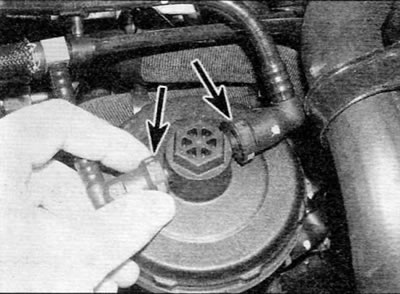
Pic. 19.24. Disconnect the quick couplings for the supply and return fuel hoses (marked with arrows) on the cover of the filter housing (early 2.0 L engines)
25. Fit a suitable socket onto the hex tab on the filter housing cover and turn the cover approximately a quarter of a turn counterclockwise to release the locking elements.
26. Remove the housing cover, metal o-ring and o-ring, and then remove the filter element (pic. 19.26, a-g).
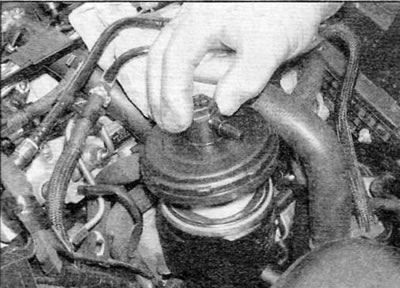
Pic. 19.26 a. Remove filter housing cover...
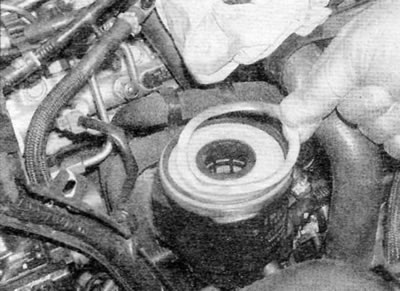
Pic. 19.26, b - remove the metal sealing ring...
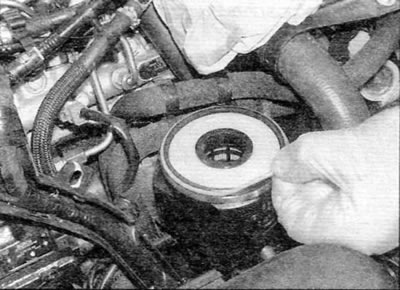
Pic. 19.26, c....and the o-ring...
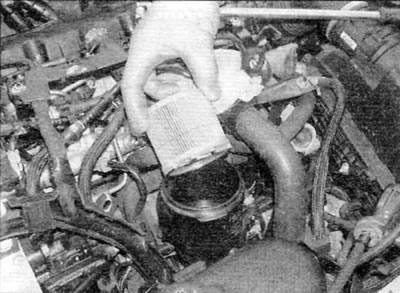
Pic. 19.26, g....then remove the filter element (early 2.0 L engines)
27. Remove the two bolts and remove the filter housing from the appropriate support bracket. Thoroughly clean the filter housing and cover, following the cleanliness requirements above. When the cleaning operations are completed, place the housing on the support bracket and secure it with two bolts.
28. Install a new filter element on the housing.
29. Lubricate the new O-ring with clean diesel fuel and install it, followed by the metal O-ring.
30. Install the housing cover and turn it clockwise until the arrow on the housing cover lines up with the filter drain port.
31. Connect the supply and return fuel hoses, and then fill the fuel system as described in chapter 4B.
32. Finally, install the engine cover.
Later models
33. Release the latches by turning them a quarter of a turn and remove the engine cover (pic. 4.11, a, b).
34. Remove all traces of dirt from the outside of the filter housing, and then drain the condensate from the fuel filter as described in paragraph 4.
35. If applicable, disconnect the electrical connector located on top of the filter housing cover (pic. 19.35).
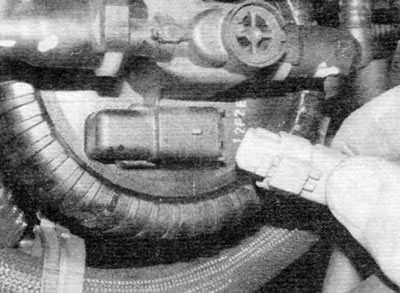
Pic. 19.35. Disconnect the electrical connector located on top of the filter housing cover (late 2.0L engines)
36. Disconnect the fuel line quick couplers on the filter housing cover using a small screwdriver to release the retaining clip (pic. 19.36). Move the fuel lines to the side and adequately plug the open ends to prevent dirt from entering.
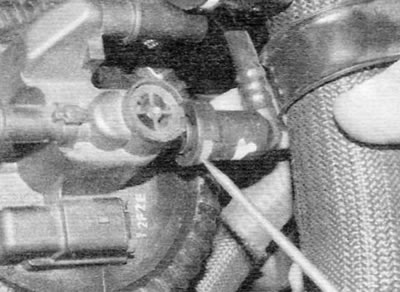
Pic. 19.36. Disconnect the quick couplings for the supply and return fuel hoses (late 2.0L engines)
37. Using a strap wrench or similar tool, unscrew the retaining ring on the filter housing. Remove the housing cover, remove the filter element and remove the sealing ring (pic. 19.37). Note. Although the circlip on the filter housing is known in theory to loosen, in practice it is often impossible to unscrew the circlip without damaging the housing, requiring replacement of the entire filter housing.
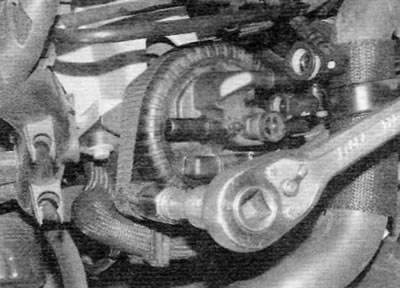
Pic. 19.37. Using a strap wrench or similar tool, unscrew the retaining ring on the filter housing (late 2.0L engines)
38. Remove the two bolts and remove the filter housing from the appropriate support bracket. Thoroughly clean the filter housing and cover, following the cleanliness requirements above. When the cleaning operations are completed, place the housing on the support bracket and secure it with two bolts.
39. Install a new filter element on the housing.
40. Lubricate the new O-ring with clean diesel fuel and install the O-ring.
41. Install the housing cover and position it so that the inlet and outlet fittings are parallel to the engine.
42. Screw the circlip onto the body and tighten it until the grooves on the ring and body are aligned.
43. Connect the supply and return fuel hoses and, if applicable, dock the electrical connector. Fill the fuel system as described in chapter 4B.
44. Finally, install the engine cover.
